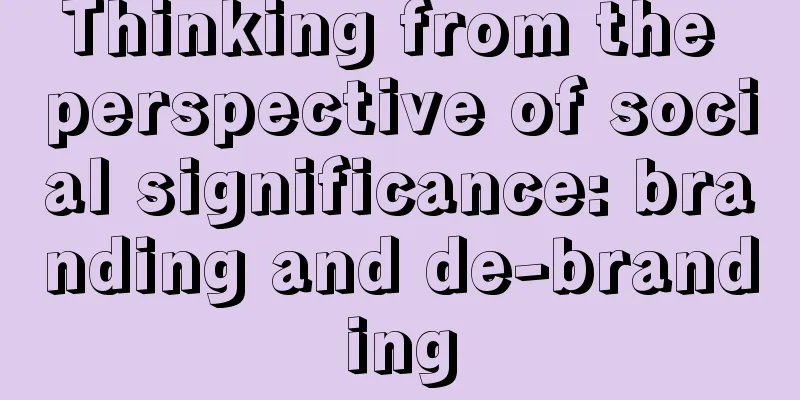Thinking from the perspective of social significance: branding and de-branding

Our entire society has a deep misunderstanding and prejudice about brands and marketing. Brands are often seen as a tax on intelligence, especially the new brands that have emerged in recent years, which are often labeled as cutting leeks. The purpose of enterprises to build brands is just to increase the added value of products and corporate profit margins. Although this increases the marketing costs of enterprises, it is consumers who pay for it in the end anyway. Moreover, brands are seen as evidence of consumerism, and their purpose is to induce and intimidate consumers into buying things they don’t need. Ubiquitous brand advertisements wantonly invade private life and public space, alienate human values, turn people into slaves of material and desire, and make the entire society vulgar, vain, and materialistic. On the other hand, in many people's eyes, marketing is synonymous with "hype". When a company is said to be good at marketing, the subtext is that it does not make products with heart, but only knows how to hype traffic. Therefore, many companies like to boast that they do not understand marketing and only know how to make products, implying that their performance depends entirely on product strength. Especially those old, outdated and about to be eliminated companies like to emphasize this the most, implying that the market has been taken away by those superficial brands, good products are not valued, and their own failure is "not their fault." In fact, these views are not new. When I was a kid, I followed my mother to buy things. In her simple consumption concept, the big brands have more advertising, and buying branded goods is a waste of money, which is to help the company pay for advertising. More than 20 years have passed, and today's arguments about brands have not made any progress. As a brand person, I think we can not only think about the commercial value of the brand, but also pay attention to the brand’s significance to people and society. This significance can be divided into two levels. 1. The social significance of brandingIn order to illustrate the necessity of brands, let me first tell you about some of my personal shopping experiences. A few years ago, I renovated my house and bought a lot of brands and products. For example, Gree's air conditioner and Bosch's smart lock had some minor problems after using them for one or two years. At that time, I called Gree's after-sales service. The service staff came to my house within 20 minutes to deal with the problem and patiently explained the problem. The headquarters called back the next day. It was a very standard after-sales processing process for big brands. The same was true for Bosch. After contacting after-sales service, the other party left my address and phone number, and without saying a word, they directly sent a new lock over, and then sent a technician to replace it at home. I have participated in a smart lock startup project and I know this industry very well. The smart lock product lines of international brands such as Bosch and Philips are actually authorized to domestic manufacturers for OEM production and OEM operation. There is no essential difference between their quality and technology and those of domestic brands. In fact, the prices are even higher because of the brand premium. But the reason I chose Bosch is that I think big brands have better service (the current technology of smart locks is not mature and it is easy to have various minor problems, so after-sales service is very important), and the facts prove that this is the case. Earlier, I bought a TV cabinet and audio set from IKEA and used it for more than four years. Because the circuit contact was poor due to moisture, I contacted IKEA for repair, but this product line had been discontinued, so IKEA directly refunded me a full refund and recycled the product. In addition to these experiences, I also bought children's study tables and chairs from an emerging domestic brand. After using them for more than a year, the chair parts broke. At that time, I wanted to find the offline store where I bought them to replace them, but when I went there, I found that it had closed in 2021. So I went to its Tmall store, but the customer service told me that the online and offline businesses belong to different owners, with different product lines, and the accessories cannot be used interchangeably; and because of poor business, the offline owner has closed down. However, the customer service was very diligent and helped me contact the original factory of the product and sent me new accessories. I heard a similar story some time ago. A netizen bought a pair of trousers from the Tmall official flagship store of an old clothing brand. Because the trouser legs were too long, he took them to an offline store to have them cut. As a result, the store did not recognize that they were its own products and told him the subtle differences between offline and online brands. As a brand practitioner, I can certainly understand this business operation of separating different channels. However, as a consumer, whether online or offline, we buy the same brand after all, so we should get the same after-sales and service guarantee. The above practices are obviously a manifestation of immaturity and non-standardization of the brand. But at least these shopping experiences were all from branded merchants, and if there were any problems, I could still find the brand. For example, when I was decorating, the cabinets for custom-made curtains were all from small merchants and individual stores. In less than half a year, there were problems such as the cabinet doors deforming, the fixing strips on them falling off, and the honeycomb curtains breaking. When I contacted them again, they were nowhere to be found, and they didn't answer the phone. It was a far cry from the enthusiasm before the purchase. Through these personal experiences, everyone can naturally feel the importance of brands. As an advertiser with 15 years of experience, I think the simplest and most practical shopping advice is to buy big brands if you can. We usually call those products that are not branded, or even have no registered trademarks, and are produced by small factories and small businesses as no-name goods. Why are branded goods generally more reliable than no-name goods, with more guaranteed quality, more worry-free service, and no after-sales disputes when there is a malfunction? Because brand is a social contract. When a company starts to build a brand, it is equivalent to signing an invisible contract with the general public. While selling products and promoting brands, the company must accept social supervision and assume social responsibility. Brand building is a systematic work that requires continuous investment of costs and resources. If there is a quality problem with a company's products, or if a consumer's after-sales service is not handled well, it may cause damage to the brand's reputation and assets, and years of investment will be wasted. Therefore, the existence of brands increases the default costs of enterprises. Enterprises must pay more attention to product quality and user maintenance, and must cherish their reputation. Therefore, building a brand is to send a signal to consumers that the company is willing to do business with consumers for a long time, rather than a one-time transaction. For consumers, brands represent credibility. Buying brands can effectively reduce decision-making risks, reduce subsequent use costs, be more reliable, and avoid pitfalls. Even if you are unlucky enough to step on a landmine, you can still protect your rights, avoid pitfalls in the future, and influence more potential consumers through the Internet, which can play an effective supervisory role for enterprises. As a social contract, brand is both a supervision mechanism and an incentive mechanism. For enterprises, building a brand is both an honor and a responsibility. Brand also acts as an amplifier for enterprises, amplifying the possible results of various business behaviors of enterprises and putting enterprises under a magnifying glass for examination. If a company performs well and its brand reputation and goodwill improve, it will attract more consumers to buy and recognize it, forming a wide social influence. On the contrary, if a company performs poorly, bad news will spread far and wide, and it will be rejected and abandoned by countless consumers. Consumers express their likes, dislikes and opinions through brands, and companies accept social supervision through brands and can obtain social rewards as a result, thus forming a positive cycle. 2. De-branding consumer philosophyIn a society dominated by consumption, people consume without restraint and without scruples. Consumption has become a form of enjoyment, showing off, venting, an attitude, a personality, representing a person's way of existence and spiritual world. Consumption has become people's belief, and brands are that religion. In this wave, people have also begun to reflect, and anti-consumerism and de-branding are becoming an important trend of thought. Many years ago, I included two such books in the must-read list for advertisers on Douban. One was "Consumer Society" and the other was "NO LOGO". "NO LOGO" was published in 2002 and became a global bestseller. The book reveals the damage done by consumerism to human beings, and the harassment and fraud of brands and their advertisements on people's daily lives. At the same time, the book proposed a new consumption concept of "NONO" and gave birth to the "NONO tribe" consumer group around the world. The NONO group advocates rational consumption, frugality, simplicity and nature, and says NO to conspicuous consumption and blindly following trends without personality. Their attitude towards brands is that they don't like brands that look the same, and they believe that relying on famous brands to show their social status is a sign of having no status . So the NONO people are not against brands. What they are against are brands that lack individuality and famous brands that are used for showing off. Their favorites are the inconspicuous but very expensive niche individual brands. Another example is the popular "old money style" today, which advocates the dress style of the old aristocracy, focusing on the material and comfort of the clothes themselves, rather than relying on big brand logos and the latest fashion items to show off like the "new money" nouveau riche. Old money people believe in no logoism, but they are not brandless. They just refuse brand logos that are too big and too conspicuous, not the brand itself. In fact, old money people pay more attention to brands. In 2018, HBO's drama series "Succession" tells the story of the Roy family, who controls the world's largest entertainment and media group, and a series of internal struggles over inheritance rights. The Roy family is a typical old-money family. They wear designer clothes everywhere, even the hat the old man wears is from the top Italian luxury brand Loro Piana. However, the clothes look low-key and simple, with the LOGO hidden inside, and no one would know unless it is revealed. Tom, the son-in-law of Roy family, wanted to fit in with the Roy family and imitated the Roy family's dressing style in every way. However, he was ridiculed for wearing a Moncler down vest with a conspicuous logo, even though Moncler is also a luxury down jacket brand from Italy. This consumption style is similar to the NONO tribe mentioned above. People simply give up the brand's function of symbolizing social status and identity, but pay more attention to the brand's function of guaranteeing product quality and value and representing self-style and attitude. The rise of brands has shaped a unified global consumer market and made the global village real and tangible. In every corner of the world, you can see people drinking Coca-Cola, eating McDonald's, using iPhones, and driving Volkswagen and Toyota cars. While most people, out of authority worship, herd mentality and risk aversion, buy brands that everyone else is buying, there are always consumers who pursue individuality and uniqueness and are more willing to choose niche and avant-garde brands. In fact, herd mentality and excellence have always been the two major coexisting consumer psychology. As consumers mature, this trend will become more obvious. Even for those consumers who don’t care what logo is printed on the products they buy and only care about quality and price, buying branded goods is the best way to ensure quality. For consumers, one can certainly believe in anti-consumerism, shop only for necessary needs, control desires, and oppose unhealthy consumption concepts such as showing off and vanity. However, it is impossible to completely give up brands in our lives, because giving up brands will lead to the quality of your life being unable to be guaranteed. In the book "Creativity is Magic", there are two thought-provoking stories. One is the bread of Eastern Europe. During the planned economy period, brands were considered meaningless, so the bread sold in stores in Eastern European countries all had the same packaging, without their own brand trademarks or product characteristics, and not even indicating which bakery produced them. Customers don’t know who produced the bread they bought, so they can’t vote with their feet and reward or punish the bread through subsequent purchases. If the bread tastes good today, there is no guarantee that you will get it again tomorrow; if the bread tastes bad today, they don’t know who to boycott. However, due to the lack of customer feedback, the quality of bread was the same, and since customers needed to buy bread every day, bakeries had no motivation to produce good bread. Soon, the bread of every bakery became equally bad, and even moldy. This is the bad money driving out the good money due to the lack of market feedback signals. Another story is about Soviet rivets. Just like bread, rivets produced by different factories are mixed together and put into warehouses, and then sent to all parts of the country as needed. Since the manufacturers cannot identify them, the factories have no motivation to produce high-quality rivets. As the production volume of rivets increases, the quality is rapidly declining, but no one knows which factory to blame. In the end, a small rivet even affected the combat effectiveness of Soviet warships, so the Soviet Union had to require each factory to mark the factory name on the rivet. The brand feedback mechanism took effect and quality was quickly restored. In 1970, the famous economist George Akerlof published a paper entitled " The Market for Lemons: Quality Uncertainty and Market Mechanisms ", in which he pointed out that when information is opaque, good products are often eliminated, inferior products occupy the market, and the market gradually deteriorates. This paper was once considered superficial and was rejected by three authoritative economics journals, but it caused a huge response after it was finally published, and ultimately helped Akerlof win the 2001 Nobel Prize in Economics, laying the foundation for "asymmetric information science." In fact, information asymmetry exists all the time. Consumers are not experts in the field and do not understand the raw materials, processes and technologies behind the products. In this case, how can we make a purchase decision? In addition to spending a lot of time and energy collecting product information, brand is a very important decision-making factor. Brand is a transmission mechanism for market signals, which can effectively transmit market feedback to enterprises, thereby motivating and supervising enterprises to provide better products and services and ensuring that consumers get good quality. Without a brand, even the quality of a screw or a loaf of bread cannot be guaranteed. This is the social significance of the existence of a brand. In this series of 30 lectures, we have been talking about the role of brands in enterprises, such as promoting sales, increasing profits, and retaining customers, as well as how marketing can create such effects. However, what is the significance of brands for society? What is their real value to consumers? This is my answer. Only branding can protect the interests of consumers and business owners, and thereby promote the vigorous development of the economy and the market. Author: Empty-handed WeChat public account: Empty Hands (ID: firesteal13) |
>>: The copywriters with a monthly salary of 50,000 yuan are all writing fences
Recommend
How to decorate a new Shopee store? What are the methods?
Merchants who open stores on Shopee will decorate ...
What does eBay import fee mean? How to collect it?
When opening a store on eBay, in fact, many newbie...
What is the process for opening a store on a cross-border e-commerce platform? How to do it?
More and more merchants want to open stores on cro...
What documents are needed for a company to settle foreign exchange? How long does it take for a company to settle foreign exchange?
Foreign exchange settlement by enterprises refers ...
Why are there huge market opportunities for 24-hour soy milk restaurants?
After getting off work late at night, you can alwa...
5 million for an advertising slogan
Advertising slogans are a very important part of b...
Taobao's balancing strategy is to encourage people to "compete with their internal strength"
Faced with the problems caused by low-priced goods...
How to follow the sale of Wish? Can I follow the sale of Wish?
On the Wish platform, follow-selling is a common s...
How many orders can Lazada place in a day? How to identify Lazada orders?
Lazada is the largest e-commerce platform in South...
Are there any sea freight costs? What are the costs of sea freight?
Nowadays, cross-border e-commerce platforms have r...
Where can I view the monthly rent deduction details on Amazon? What should I do if the monthly rent is not deducted successfully?
Users who participate in the monthly rental plan o...
What does Amazon Prime Day mean? How to improve the registration pass rate?
If Amazon merchants want to attract traffic to the...
The debate over whether to keep "refund only"
As e-commerce is developing rapidly, the convenien...
From recommendation to search, 3000 words to explain Xiaohongshu traffic!
Xiaohongshu's traffic comes from three sources...
How to write a qualified brief for Xiaohongshu
In the process of working with KOLs, a detailed br...









